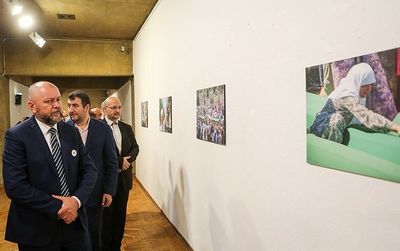The two-day exhibition entitled “White Stones and Broken Hearts” opened on Monday to commemorate the 27th anniversary of the massacre of over 8,000 Bosnian Muslim men in what was Europe’s worst civilian slaughter since World War II.
The photos are from a collection by Iranian photographer Mehdi Salehi who amassed the series during his visits to Bosnia and Herzegovina.
Part of the collection also consists of photos of people attending the Annual Peace March or Mars Mira in Bosnia and Herzegovina organized in memory of the victims of the 1995 genocide by Bosnian Serb forces.
The three-day walk running from July 8 to 10 starts from a village called Nezuk (Sapna Municipality) and over a three-day period covering a distance of some 90 kilometers, reaches Potocari, the final resting place for many of those massacred.
The ambassador of Bosnia and Herzegovina, Samir Veladzic, was among the guests present during the opening ceremony of the showcase.
In his short speech, Veladzic said that the memory of the victims of the massacre lives on and added, “The Srebrenica Genocide is a catastrophic historical event and all the world must learn important lessons about the massacre and must never forget it.”
He expressed his thanks to Iran for its support of the Bosnian people during the Bosnian war and said, “The government of Iran and Iranian people express their sympathy for Bosnian people on the anniversary of this tragic event every year, and we remember the Iranian soldiers who were martyred in the Bosnian war to bring peace and justice back to the country.”
The exhibition was organized with contributions from the Women’s International Cultural Relations Office of Iran’s Islamic Culture and Relations Organization.
“Now, we are commemorating the 27th anniversary of the sad event and remembering the victims of the Srebrenica Genocide, which came to a total of 8,372,” Saeideh Baqerizadeh, the director of the office, said during the opening ceremony of the exhibition.
“This exhibition has been organized in memory of the genocide victims to heal the wounds of the war in Bosnia and to recall a vicious crime, which was ignored by the West and all international human rights organizations,” she added.
The Srebrenica offensive commenced on July 6, 1995, with Bosnian Serb forces advancing from the south and burning Bosnian homes along the way. Amid chaos and terror, thousands of civilians fled Srebrenica for the nearby village of Potocari, where a contingent of about 200 Dutch peacekeepers was stationed.
Some of the Dutch surrendered, while others withdrew; none fired on the advancing Bosnian Serb forces. On July 11, Bosnian Serb military leader Ratko Mladic strolled through Srebrenica and, in a statement recorded on film by a Serb journalist, said, “We give this town to the Serb nation… the time has come to take revenge on the Muslims.”
For the first time, the Dutch government on Monday apologized to the relatives of the victims for the role played by Dutch peacekeepers in the Srebrenica Genocide.
Source: Tehran Times

